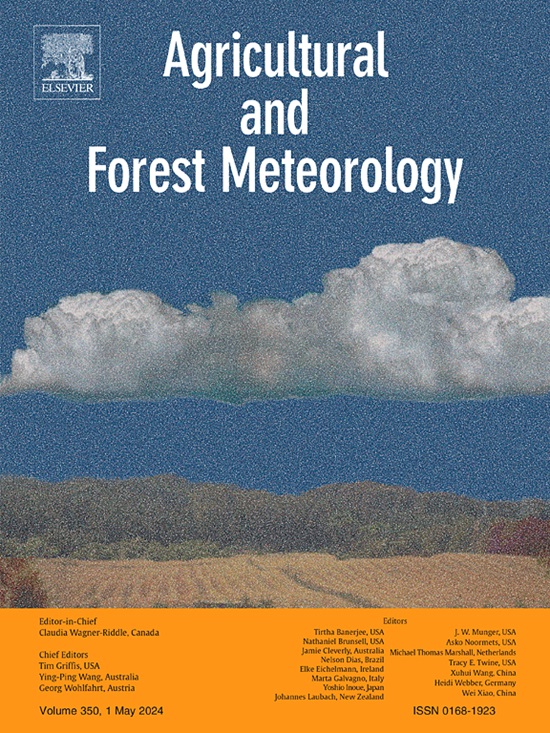Carbohydrate allocation strategies in leaves of dominant desert shrubs in response to precipitation variability
IF 5.6
1区 农林科学
Q1 AGRONOMY
引用次数: 0
Abstract
Climate change has significantly altered precipitation patterns worldwide, resulting in more frequent and intense droughts and heavy rainstorms, particularly in vulnerable ecosystems such as arid deserts. This study investigated how dominant desert shrubs, the C3 plant Kalidium gracile and the C4 plant Salsola passerina, respond to varying precipitation regimes. A six-year controlled experiment (2016–2021) employing a five-level precipitation gradient, ranging from extreme drought to increased water availability, was conducted to elucidate changes in leaves carbon content and its components under these conditions. Results indicated a substantial increase in starch (ST) content in S. passerina under heightened rainfall conditions (P < 0.05), whereas K. gracile showed a propensity tendency to accumulate ST content under moderate drought condition. These findings indicated distinct adaptive strategies between the two species in response to water availability. Additionally, both shrubs maintained a relatively stable ratio of non-structural carbohydrates (NSC) to structural carbohydrates (SC) (P > 0.05), suggesting an active regulation of carbon balance within plant structures, independent of precipitation changes. Notably, S. passerina demonstrated greater responsiveness to precipitation alterations compared to K. gracile, highlighting species-specific differences in carbon allocation strategies. This study provides mechanistic insights into plant carbon dynamics in response to precipitation changes in desert ecosystems, contributing to a deeper understanding of carbon cycling processes and ecosystem functioning in arid landscapes.
优势荒漠灌木叶片碳水化合物分配策略对降水变异的响应
气候变化极大地改变了全世界的降水模式,导致更频繁和更强烈的干旱和暴雨,特别是在干旱沙漠等脆弱生态系统中。本研究研究了优势荒漠灌木C3植物细柄钾和C4植物Salsola passerina对不同降水条件的响应。通过为期6年的对照实验(2016-2021),采用从极端干旱到增加水分可用性的5级降水梯度,研究了这些条件下叶片碳含量及其组分的变化。结果表明,在强降雨条件下,棘豆淀粉(ST)含量显著增加(P <;0.05),而在中等干旱条件下,细叶松表现出积累ST含量的倾向。这些发现表明,两种物种对水供应的适应策略不同。此外,两种灌木的非结构性碳水化合物(NSC)与结构性碳水化合物(SC)的比例保持相对稳定(P >;0.05),表明植物结构内的碳平衡具有主动调节作用,不受降水变化的影响。值得注意的是,与细叶松相比,雀尾松对降水变化的响应更大,这突出了碳分配策略的物种特异性差异。该研究为荒漠生态系统中植物碳动态响应降水变化提供了机制见解,有助于更深入地了解干旱景观中碳循环过程和生态系统功能。
本文章由计算机程序翻译,如有差异,请以英文原文为准。
求助全文
约1分钟内获得全文
求助全文
来源期刊
CiteScore
10.30
自引率
9.70%
发文量
415
审稿时长
69 days
期刊介绍:
Agricultural and Forest Meteorology is an international journal for the publication of original articles and reviews on the inter-relationship between meteorology, agriculture, forestry, and natural ecosystems. Emphasis is on basic and applied scientific research relevant to practical problems in the field of plant and soil sciences, ecology and biogeochemistry as affected by weather as well as climate variability and change. Theoretical models should be tested against experimental data. Articles must appeal to an international audience. Special issues devoted to single topics are also published.
Typical topics include canopy micrometeorology (e.g. canopy radiation transfer, turbulence near the ground, evapotranspiration, energy balance, fluxes of trace gases), micrometeorological instrumentation (e.g., sensors for trace gases, flux measurement instruments, radiation measurement techniques), aerobiology (e.g. the dispersion of pollen, spores, insects and pesticides), biometeorology (e.g. the effect of weather and climate on plant distribution, crop yield, water-use efficiency, and plant phenology), forest-fire/weather interactions, and feedbacks from vegetation to weather and the climate system.

 求助内容:
求助内容: 应助结果提醒方式:
应助结果提醒方式:


